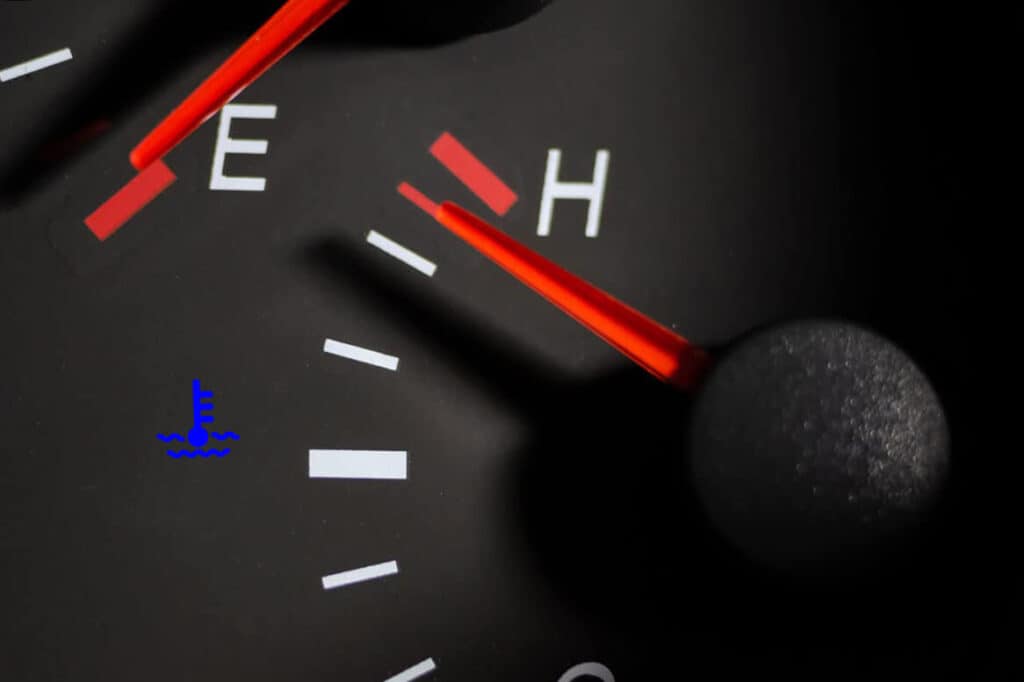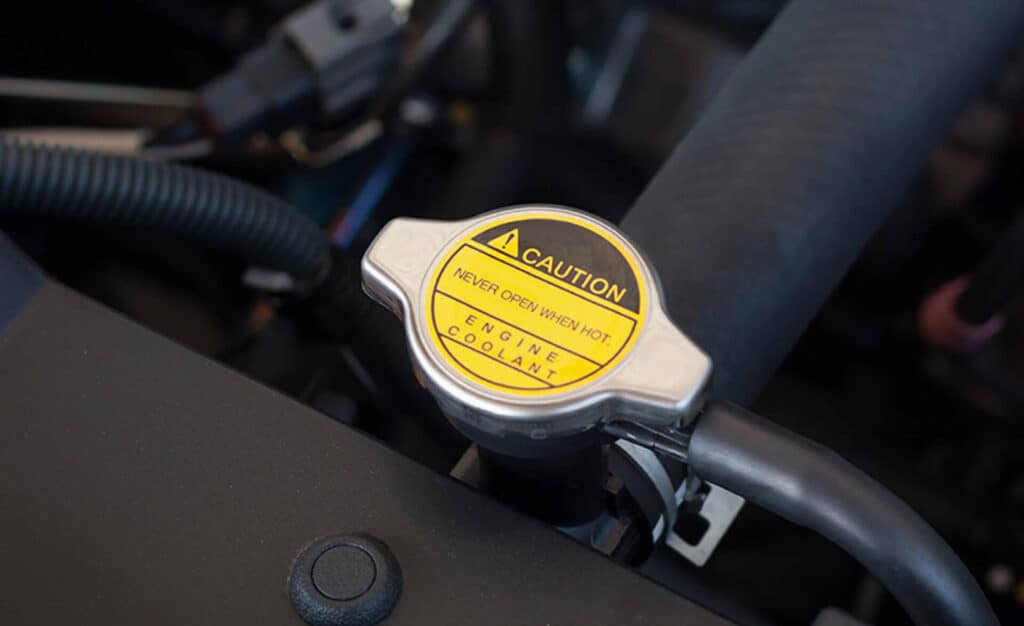Navigating the Coolant Light Alert
Your vehicle is a marvel of engineering, and to keep it running smoothly, it relies on various systems, one of which is the coolant system. Understanding the role of the coolant light in your vehicle’s health is crucial for every driver. In this guide, we will illuminate the significance of the coolant light, what it means when it starts blinking on your dashboard, and most importantly, what steps you should take to ensure your engine’s well-being.
Decoding the Coolant Light: Understanding What It Means
When your vehicle’s coolant light suddenly illuminates on the dashboard, it’s akin to receiving an urgent message from your car. It’s signaling that something within your engine’s cooling system requires your immediate attention.
The coolant light serves as a sentinel for your engine’s temperature regulation. When it comes to engine health, maintaining an optimal temperature is paramount. An excessively hot engine can lead to a litany of problems, including reduced efficiency, increased wear and tear, and even engine overheating.
Several factors can trigger the coolant light, each with its own set of implications. One of the most common culprits is low coolant levels. The coolant, also known as antifreeze, plays a pivotal role in maintaining the engine’s temperature within the safe operational range. When the coolant level drops below the minimum required, it can disrupt this delicate balance, causing the engine to run hotter than intended.
However, the story doesn’t end with low coolant levels. The coolant light can also be an early warning sign of more complex issues. Understanding the significance of the coolant light is vital because ignoring this warning can have severe consequences.

Immediate Actions: What to Do When the Coolant Light Comes On
1. Pull Over Safely: The moment you notice the coolant light blinking on your dashboard, safely maneuver your vehicle to the side of the road. Ensure you are in a secure location, away from traffic.
2. Turn Off the Engine: Once your vehicle is safely parked, turn off the engine immediately. This helps prevent further overheating and potential engine damage.
3. Allow Engine to Cool: Give your engine time to cool down. This typically takes around 30 minutes. Opening the hood while the engine is still hot can be dangerous.
4. Open the Hood: Carefully open the hood of your vehicle. Use the safety latch and wear gloves if possible to protect your hands from any residual heat.
5. Check the Coolant Reservoir: Locate the coolant reservoir, which is a translucent plastic container, often marked with “max” and “min” levels. Inspect the level of coolant inside. If it’s below the “min” mark, you’ll need to add more coolant.
6. Wait for Engine to Cool Further: Before attempting to add coolant, wait for the engine to cool down further. You should be able to touch the radiator cap without discomfort.
7. Add Coolant: Once the engine is sufficiently cool, open the coolant reservoir cap by turning it counterclockwise. Slowly pour the appropriate type of coolant into the reservoir until it reaches the “full” or “max” level. Do not overfill, as excess coolant may spill when the engine heats up.
8. Replace Reservoir Cap: Carefully secure the coolant reservoir cap by turning it clockwise until it’s firmly closed.
9. Dispose of Old Coolant Responsibly: If you’ve replaced coolant, ensure that you dispose of the old coolant responsibly. It can be harmful to the environment and should not be poured down the drain. Local recycling centers often accept used coolant for proper disposal.
Troubleshooting Common Coolant Light Triggers
When that ominous coolant light on your vehicle’s dashboard starts to glow, it’s essential to understand that several factors could trigger it. While low coolant levels are a frequent culprit, there’s a more complex landscape of potential issues to consider.
One of the most common reasons for the coolant light to illuminate is a drop in coolant levels within the reservoir. This can result from minor leaks, evaporation, or insufficient coolant maintenance. However, it’s not always about the coolant level. Sometimes, it’s a malfunctioning coolant temperature sensor that causes the light to turn on. This sensor monitors the engine’s temperature and can send inaccurate signals, leading to a false warning.
Another possible trigger is a faulty thermostat. This small but critical component can disrupt the engine’s temperature regulation, causing it to run hotter than usual. This, too, can prompt the coolant light to activate. In some cases, a radiator leak can be the root cause of the coolant light issue. Even minor leaks can result in a gradual loss of coolant, triggering the warning system.
Perhaps one of the most perplexing scenarios is when the coolant light persistently illuminates, even when coolant levels are adequate. When this occurs, it’s advisable to have your vehicle inspected by a qualified mechanic. They can delve into the intricacies of your vehicle’s cooling system, identify the underlying problem, and provide the necessary repairs or adjustments. Understanding these various factors that can trigger the coolant light is essential for prompt and accurate diagnosis. By addressing the root cause, you can ensure the long-term health and efficiency of your vehicle’s cooling system.
The Cost of Coolant: Understanding Pricing and Choices in Canada
In Canada, the price of coolant can vary depending on several factors, making it essential to make informed choices. One of the primary determinants of coolant cost is the type of coolant you select. Coolants come in different types, with ethylene glycol-based and propylene glycol-based options being the most common. Traditional ethylene glycol-based coolants are often more affordable, with prices ranging from $15 to $25 per gallon. On the other hand, newer and more environmentally friendly propylene glycol-based coolants may cost slightly more, averaging around $20 to $30 per gallon.
Within each type of coolant, you’ll find various brands and formulations, and prices can vary among these brands. Some premium options may command higher costs, so it’s essential to consider your vehicle’s specific requirements and budget when choosing a brand. The key to selecting the right coolant is ensuring compatibility with your vehicle’s specifications. Consult your vehicle’s manual or seek advice from a qualified mechanic to determine the coolant type that best suits your car’s needs.
While the initial cost of coolant is a consideration, it’s also essential to factor in the long-term value. Quality coolant can contribute to the efficient operation of your vehicle’s cooling system, potentially preventing costly repairs down the road. By understanding the pricing and choices associated with coolant in Canada, you can make an informed decision that aligns with your vehicle’s needs and your budget, ensuring proper maintenance of your car’s cooling system.
DIY Coolant Management: How to Safely Top Up Your Coolant
Topping up your coolant can be a straightforward DIY task, provided you follow the necessary precautions:
1. Ensure a Cool Engine: Always perform coolant maintenance when the engine is cool. Never attempt to work on the cooling system when the engine is hot.
2. Locate the Coolant Reservoir: Identify the coolant reservoir in your vehicle’s engine compartment. It’s typically a translucent plastic container, making it easy to see the coolant level.
3. Check the Coolant Level: Inspect the coolant level in the reservoir. It should be between the “min” and “max” markings. If it’s below the “min” mark, you’ll need to add more coolant.
4. Select the Correct Coolant Type: Refer to your vehicle’s manual or consult a mechanic to determine the appropriate type of coolant for your vehicle. Coolants come in various colors, so it’s essential to use the correct one.
5. Open the Reservoir Cap: Twist the coolant reservoir cap counterclockwise to open it. Be cautious if the engine was recently running, as the system may still be pressurized.
6. Slowly Add Coolant: Carefully pour the coolant into the reservoir until it reaches the “full” or “max” level. Avoid overfilling, as excess coolant can spill when the engine heats up.
7. Secure the Cap: After adding coolant, firmly close the coolant reservoir cap by turning it clockwise until it’s tightly sealed.
8. Dispose of Old Coolant Properly: If you’ve replaced coolant, dispose of the old coolant responsibly. It should not be poured down the drain or discarded in the environment. Recycling centers often accept used coolant for safe disposal.
By following these detailed steps, you can safely address coolant-related issues and ensure the well-being of your vehicle’s engine.

Long-Term Coolant Care: Maintenance Tips and Frequency
• Regular Check-Ups: To maintain your vehicle’s engine health, it’s essential to incorporate regular coolant system check-ups into your routine. Aim to inspect coolant levels and condition at least once a month.
• Contamination Concerns: Over time, coolant can become contaminated with impurities, which can reduce its effectiveness in regulating engine temperature. Keeping your coolant clean and free of debris is crucial for optimal engine performance.
• Replacement Intervals: Determine the recommended coolant replacement interval for your specific vehicle. Typically, coolant should be replaced every two to five years, depending on your car’s make and model. Refer to your vehicle’s manual or consult a mechanic for guidance.
• Signs of Trouble: Stay vigilant for potential coolant system issues. Watch for visible coolant leaks, fluctuations in the temperature gauge readings, or any unusual engine behavior. Early detection can prevent more significant problems down the road.
By following these detailed points, you’ll be well-equipped to understand the significance of the coolant light and maintain your vehicle’s cooling system for optimal performance and longevity.
Conclusion: Ensuring Engine Health with Proper Coolant Practices
In conclusion, the coolant light in your vehicle serves as an early warning system to protect your engine from overheating and potential damage. When it comes to your vehicle’s cooling system, prompt action is key to maintaining engine health and prolonging its lifespan. Regular coolant checks, responsible coolant management, and seeking professional assistance when needed are essential steps every driver should take. By doing so, you not only ensure the reliability of your vehicle but also enhance road safety for yourself and others.
When it comes to vehicle maintenance and repair, Uchanics mobile mechanic services in Canada are here to assist you. Whether you need a coolant system check or any other automotive service, our team of skilled professionals is just a call away. Drive safely and keep your engine in top condition with proper coolant practices.
